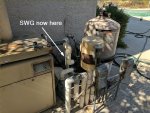So based on all this information and the pictures you are showing of your pool, I believe you may be experiencing a little bit of a “short pipe” effect - chlorine gas is not fully dissolving into the water and is being carried along by a very high velocity water stream where it exits mostly out of one return. When chlorine gas is generated at the anode, there is a resulting generation of hydroxide ion (OH-) at the cathode. When chlorine gas dissolves in water there is what's called a disproportionation reaction where by half the chlorine atoms form hypochlorous acid and the other half go back to chloride ions (Cl-). That reaction is partially acidic and reduces some of the pH rise that would occur from the hydroxide created. Over time, with sanitation and oxidation reactions being acidic, the net effect would be a neutral effect on pH. BUT, if chlorine gas is generated and allowed to escape, then there is no formation of hypochlorous acid and the pH will rise quickly from the formation of hydroxide ion.
This is why I wanted you to block off the return with a plug to force better distribution of your pool water. If the amount of gas coming out of a return is enough to soak the coping above it, then that is a problem as it suggests a very high water velocity with lots of bubbles coming to the surface. A dye test would likely reveal the extent of the hydraulic mixing pattern of your current plumbing setup.
In practice, you need several fixes (in no specific order) -
1. All of those return pipes need to be fitted with eyeballs to adjust flow. I realize that this is "after the fact" but open pipes for returns result in very poor hydraulic mixing of the water.
2. A variable speed pump, or at the very least a 2-speed pump, would help you to slow down the water flow and give the chlorine more time to mix and dissolve. Given that CA has banned single speed pump motors and Federal regulations will soon follow, a cheap solution if your have 240V at the pump would be to simply swap out the motor with a 2-speed with enough HP so that the flow switch of the SWG is activated at low speed. 2-speed motors are cheap and you could easily recover the cost in a few seasons.
3. Installing a valve to turn off the spa return pipe (was it one pipe, like a spa makeup return or is only the multiple pipes where spa jets would normally be??). Running the spillover constantly is no good for your pH and if you are having trouble with dissolving chlorine gas, a turbulent spillover is only going to make matters worse. I have an attached spa as well and I only need to run chlorinated water through it for about 90mins per day to keep it sanitized (I break it up into two 45min runs because it is on automation).
4. An optional approach to getting a new pump would be to plumb the SWG cell in a bypass configuration where you can reduce the amount of water flow into the cell and try to see if that helps with mixing. Obviously you need to satisfy the flow switch but it may help.
5. Running the SWG at lower output for longer pump run times would help to generate smaller amounts of chlorine that may be able to mix more easily. I realize that with a single speed pump that means more electricity usage and expense, but it's generally easier on the cell to run it in shorter intervals. Clearly running the SWG longer at lower output necessitates Point #2 to reduce costs.
The above is just my opinion and suggestions, you can do with that as you may. But I really do think the RJ-60+ is working and that it is the configuration of it that is causing issues.


